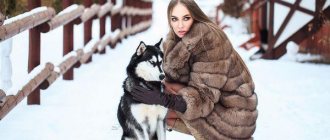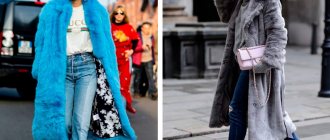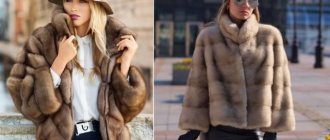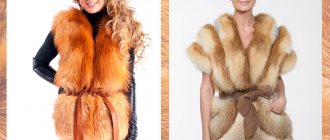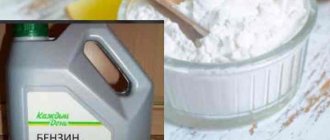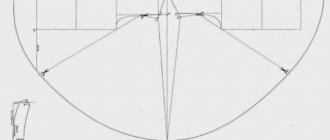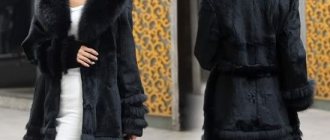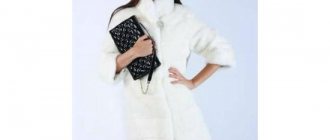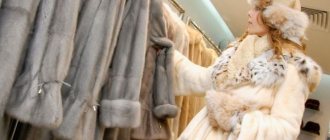Even global warming will not force a woman to give up a beautiful, soft, warm and cozy fur coat. Natural fur is a very popular element of modern fashion, having a truly magical effect on beautiful ladies. And not only because a fur coat made of natural fur saves you in cold weather and is pleasant to wear, but also because it adds elegance and chic to the owner’s image. In other words, the question of having or not having is unimportant, but the question of how to choose a quality fur coat is always relevant!
Fur, as you know, is the most ancient material. Primitive people made clothes from skins, obtained by hunting. Their functionality was limited by the need to keep warm, and the cost was equal to the physical costs of the hunter. Nowadays, the value of fur clothing sometimes reaches sky-high heights, and in order to purchase an expensive new thing, you just need to go to the store.
IMPORTANT!
Table of wear resistance of different types of fur
| Fur name | Wear resistance of fur in points |
| Otter unplucked | 100 |
| Wolverine | 100 |
| Otter plucked | 95 |
| Brown and black bear | 95 |
| Kamchatka beaver (sea otter) | 95 |
| Plucked river beaver | 85 |
| Natural seal | 80 |
| Natural sable | 80 |
| Painted seal | 75 |
| Natural raccoon | 75 |
| Leopard | 75 |
| Painted sea cat | 70 |
| Natural skunk | 70 |
| Natural mink | 70 |
| Soft natural marten | 65 |
| Sable tinted | 65 |
| Painted raccoon | 60 |
| Astrakhan | 60 |
| Arctic fox blue | 60 |
| Natural wolf | 60 |
| Smushka | 60 |
| Painted skunk | 55 |
| Dyed mink | 55 |
| Sheepskin | 55 |
| Painted soft marten | 50 |
| Natural mountain marten | 45 |
| Muskrat | 45 |
| Opoek | 45 |
| Korsak | 45 |
| White Arctic fox | 45 |
| Painted mountain marten | 45 |
| Natural fox | 40 |
| Painted wolf | 40 |
| Nutria unplucked | 40 |
| Opossum | 40 |
| Painted fox | 35 |
| Painted muskrat | 35 |
| Foal | 35 |
| Polecat | 35 |
| Natural lynx | 30 |
| Jackal | 27 |
| Natural squirrel | 27 |
| Fox painted black | 25 |
| Ermine | 25 |
| Columns | 25 |
| Nutria plucked | 25 |
| Possum painted | 20 |
| Wiesel | 20 |
| Lynx painted | 20 |
| Painted squirrel | 20 |
| sand squirrel | 20 |
| Marmot | 20 |
| Goat | 15 |
| Broadtail | 15 |
| Chinchilla | 15 |
| Rabbit | 12 |
| Common gopher | 10 |
| Brown hare | 5 |
There is a comparative wear resistance of fur types in points, where the wear resistance of otter fur is taken as 100 points, corresponding to approximately 20 winter seasons of use, subject to proper storage.
Length and style of fur coat.
If you are buying your first fur coat, it is better to give preference to classic options, such as a coat with a belt with an English collar or hood. Such a fur coat of the right length will always be appropriate. Floor-length fur coats are good for going out; such a fur coat should also be of a classic cut, because most often, with such a fur coat it is customary to wear an evening dress and boots with heels. Such a fur coat is usually purchased third or fourth in a row. The ideal choice for every day would be a knee-length fur coat; such a fur coat looks good with jeans, classic trousers, and classic skirts. For those who spend most of their time behind the wheel, a fur coat option for car ladies has long been invented. But any fur, even the highest quality, if you constantly sit on it in heated seats, will begin to come out and thin out. And of course, don’t forget about such fur products as vests and jackets with short sleeves under long gloves.
Different coats for different purposes
A beautiful, fluffy, soft and warm fur coat is rightfully one of the most beloved and desired winter outfits for any woman. When choosing this product, you need to pay attention to many different parameters, among which the most important are:
- fur color;
- structure;
- life time.
The purposes for purchasing a fur coat may vary. Some people need long and warm mink products for reliable protection from severe winter frosts. Others are looking for a short, functional sheepskin coat that will always make them feel comfortable while driving. And still others want to buy a fur coat to go with a luxurious evening dress for a specific special event. In the latter case, service life does not play a decisive role, but in the first and second cases it is extremely important.
Manufacturer's collection
The SAGITTA factory offers fur coats made from natural material. Fashionable models, among which everyone will choose an option to their taste, will allow you to look elegant.
Advantages:
- The factory and chain of stores SAGITTA uses wild American raccoon skins for the production, which is famous for its beautiful fur, as well as good characteristics, which ensures the quality of clothing. Designers create sketches based on fashion trends, and each model is unique and original.
- Models are developed based on such features as the length of the pile and its volume. We offer many styles, but the most popular are loose and half-flared. This raccoon model looks feminine regardless of its length and color.
- A special feature of SAGITTA is the ability to choose models made from natural materials, as well as their good cut. The factory offers outerwear that is known for its high quality tailoring and cool fit.
Before choosing a fur coat, you can view the full catalog on our website. A complete description and characteristics of the products, as well as photographs, will allow you to choose a fur coat that suits your preferences. You can ask questions to our specialists, who will advise you on each model.
Which fur is the most reliable and durable?
When going to the store to buy a new fur coat, you definitely need to know that each type of popular fur has different degrees of wear resistance, which affect their service life. To significantly facilitate the selection process, a special table was created, which indicates the average service life of fur coats made according to GOST from various furs. It should be noted that the wearing period of these products is measured not in years, but in seasons, each of which in our climatic conditions consists of approximately four months.
So, the rating of the most durable and wear-resistant furs looks like this:
- otter;
- beaver;
- sable;
- mink;
- astrakhan;
- sheepskin and mouton;
- arctic fox;
- marten;
- lynx.
The undisputed leader in wear resistance is otter fur. Products made from it can last from 20 to 22 seasons. They are confidently followed by beaver fur coats, whose service life ranges from 18 to 20 seasons. The third position rightfully belongs to fur products made from sable. The average period of their wear is 16-17 seasons. In fourth place are mink coats, beloved by many. The approximate lifespan of a mink coat is twelve to fifteen seasons. A slightly shorter wear period is typical for fur coats made from astrakhan fur - approximately 12-14 seasons.
The approximate service life of warm fur products made from mouton and sheepskin is about eleven seasons. A slightly lower degree of wear resistance is inherent in fur coats made from arctic fox. They reliably serve their owners for 9-10 seasons. Beautiful coats made from lynx and nutria can last for five to six seasons.
Fur as a material
Let's start with the definition. A fur skin is the outer covering of an animal, which consists of skin (skin tissue) and hair (fur). Fur semi-finished product is a raw material (unprocessed skin) that has been subjected to physical-mechanical, chemical, and physical effects. It is worth noting that some sections of the semi-finished product have different values and names. So they differ in topographic pattern, skin, and hair.
Topographic drawing
Semi-finished products differ in areas such as:
- Spine side. This includes the sacral, dorsal, and nape of the body.
- Scruff. In the animal it is located between the top of the shoulder blades and the ears.
- Womb. The base is between the front and hind legs on the abdomen.
- Rump or Chemer. The cross part of the animal’s body is the lower part of the ridge.
- Collar or Zavoek or Neck. The part of the neck up to the line where the upper hollow of the front legs meets the upper part of the ridge.
- Ridge or Back. Part of the skin along the spine.
- Flanks. Skin without fur, at the junction with the floors of the paws.
- Sides. Side parts of animal skin.
- Darling. The throat and chest area, the upper part of the womb.
- Dyl. This is the lower part of the womb.
- Paws. They are divided into 2 (two) types: paddle (upper part) and cat (lower part).
- Tail. Its upper part is called a turnip, its lower part is called a tipunok.
It is worth understanding: the border of each of the areas can vary dramatically among different animals.
As for product properties, then:
- Lobs have hair that differs significantly from the main one, and is divided into thick and dense or smooth and hard. The flesh in this place is always dense, and the part itself is used to make solid heads or forehead bellows.
- The ears have smooth, short hair with a thin inner layer. Used extremely rarely.
- The neck is a rather controversial area of the skin, since in each animal it has a different hair direction, color, and inner skin from the main skin (however, more often it is hard and thick). Therefore, it is used only for sewing neck furs.
- The ridge is, in most cases, the most valuable part of the skin from which a full-fledged product is sewn. And unlike the neck, the rump has a thick interior, thicker than hair.
- The sides, unfortunately, are of lower quality than the spine, however, they are used in the same way in tailoring. The flesh is softer than the spine.
- The groin has coarse, sparse hair with weak flesh. Therefore, it is used as a foot flap, cut from the general part of the skin.
- The upper part of the womb has shorter hair than the lower part. But the hair is sparse and differs significantly from the structure of the entire hairline. The same difference has the color (lighter than the ridge) and the core (again weaker than the ridge). The exception to the rule is the skin of a muskrat. The belly of expensive fur is always used as a separate product. In other cases - a foot flap.
- The paws are smooth, hard, smoothed hair and thick flesh in the lower part. If removed and processed correctly, this is for an independent product, and with claws it will cost more.
- The tail is sometimes similar in color to the color of the paws, but is completely different from the hair of the entire part of the skin. Some animals have no fur at all, for example, the river beaver. A flogged or whole type is used for tailoring.
If we talk about the rational use of skins, then the tubular type (that is, removing with a stocking) is the most profitable (by the way, valuable furs are supplied in this form). However, for painting it is better to use ripped skins.
Skin covering
It consists of three parts: the epidermis (a layer of skin made of thin keratinized cells), the dermis (the basis of the skin, consisting of collagen fibers) and the mesra or subcutaneous tissue (located under the dermis and in most cases must be removed).
In this case, the dermis is interesting, since the quality of the skin depends on it. It is divided into papillary and reticular layers. The first one is penetrated by hair shafts, since the hair follicles are located there. The second is just a layer of collagen.
The most important thing is the depth of hair in the dermis, since the quality of fleshing will directly depend on knowledge of these nuances. So, for example, in a marmot, ferret, muskrat, goat, the hairline is extremely deep - up to 70% (seventy percent) of the dermis.
The thickness of the leather fabric is the mass of the fur, as well as its wear resistance. The thickness varies between 0.2 - 3 mm (zero point two - three millimeters). Thin fabrics include squirrel, arctic fox, weasel, and ground squirrel; thick fabrics include sheepskin, otter, seal, and wolverine.
Hairline
As mentioned above, the hair in the thickness of the fabric is the root part, and above the surface is the shaft. Part of the skin consists of certain types of hair:
- Guides.
- awns.
- Downy ones.
The so-called “veil” of hair is the guide hair. Moreover, they are characteristic of some types of fur-bearing animals. Elastic, thick and long, they differ in color, being divided into color categories.
There are much more thin guard hairs that cover the downy hairs, serving as their support. The color is pigmented.
Down hairs are also called “down hairs”, since they are the thinnest, shortest, but large in number. They are responsible for the heat-protective properties of a fur coat.
A few words about hair:
- Natural fur colors are gray, white, red, black, brown, brown, blue;
- Hair shine is an increase in value, an improvement in appearance. It depends on what time of year the animal was killed, in what conditions the animal lived, and how well the skin was processed.
- Softness, thickness, height are indicators of the value, beauty and heat-protective properties of fur. In height there are: short-haired (up to 2 (two) centimeters) - this is a gopher, rabbit and more, medium-haired (from 2 (two) to 4 (four) centimeters) - this is a marten, mink, rabbit, sable and similar, long-haired (from 4 (four) to 10 (ten) centimeters) – wolverine, arctic fox, otter, beaver, fox, badger, wolf and others. Based on density, they are divided into: especially sparsely haired - less than 2,000 (two thousand) hairs per 1 cm2 (one square centimeter), densely haired - 12,000 - 20,000 (twelve - twenty thousand) per 1 sq.cm. (one centimeter square), especially thick-haired - more than 20,000 (twenty thousand) per 1 square cm. (one square centimeter).
- Elasticity is the ability to restore appearance after being crushed. Elasticity = fluffiness of fur.
- Feltability. The term shows how quickly hair falls off during use of a fur product.
Which furs have a shorter service life?
No less important and useful will be information about the types of natural furs, which are characterized by a shorter service life - that is, up to approximately five seasons. Their rating is as follows:
- fox;
- nutria;
- marmot;
- squirrel;
- chinchilla;
- rabbit.
Thus, a fox fur product is designed for approximately five seasons of wear. Fur coats made from nutria have exactly the same wear resistance. They are followed by squirrel and marmot furs - winter clothes made from them can be worn for four seasons. Three to four seasons is the declared service life for squirrel and marmot fur coats made in accordance with GOST. Products made from chinchilla can reliably serve for approximately exactly the same period of time. The shortest service life is typical for rabbit fur coats - as a rule, it is only two seasons.
How to choose a fur coat: expert advice
If you decide to spend money not on a trip, but on a fur coat, now is the time! And we will tell you how to choose a better fur coat...
What is the most wearable fur coat?
- Made from otter and river beaver fur (not plucked!) it will last 18-20 seasons;
- From seal fur - 17 seasons;
- From mink - 10 seasons;
- From marten and white fox - 7 seasons;
- From astrakhan fur, sheepskin (aka mouton) and seal - 6 seasons;
- Muskrat, fox, plucked nutria - 5 seasons;
- From squirrel and marmot - 4 seasons;
- From rabbit and hare - one to two years;
- Chinchilla and rabbit (hare) – 1-2 seasons.
But experts advise also taking into account the intensity of use of the products. If 15-20 years ago a fur coat was still a relative luxury, now it has become an everyday item. So if you wear the same mink constantly, then, according to the Russian Fur Union, the estimated duration of wearing such a product will be about 6 seasons (instead of 10). And then - if the thing is of high quality. Also, dyed furs wear out 10-20% faster
At the same time, the durability of sheared fur (which warms worse) is 20-40% higher, and fur coats made from whole skins are about 20% more durable than even a well-sewn fur coat made from scraps.
Which fur coat is the warmest?
We, of course, are far from the Arctic, but even -20 in the same Epiphany frosts can last a week or two. So if you’re going to choose a fur coat, it’s not to show off your eyes, but to warm your soul and body. The warmest fur is considered to be the skins of reindeer (they are also sold), arctic fox, raccoon dog, fox, beaver, marten and sable. A less warm fur coat is made from mink, kolinsky, astrakhan fur, ermine, and chinchilla. Products made from rabbit, goat, and marmot fur have reduced heat resistance. And the fur of a hamster and gopher warms up very poorly.
Which fur coat is the lightest?
But the same non-carrying and cold hamsters, gophers and hare are considered the lightest. Medium-weight products are made from mink, rabbit, nutria, muskrat, squirrel, and ferret. And the heaviest fur coat is made from the skin of a wolf, raccoon dog, otter, beaver, arctic fox, sable, astrakhan fur.
Much also depends on the thickness of the fur, when the animal was slaughtered (winter fur is the most beautiful and fluffy), whether it went through a thinning (pinch) or shearing procedure.
In plucked fur, the guard hair is removed entirely (plucked); when shearing, it is shortened. The essence of plucking is that the coarser hair is removed from the fur, after which only the velvety underfur remains on the skin. The result is a texture reminiscent of natural velvet, very pleasant to the touch. Pinching is a more expensive operation than shearing (especially since after pinching the skin is in most cases trimmed to even out the height of the fluff). But plucking, alas, although it makes the fur nice and light, after that it is only suitable for very slight frosts.
After cutting, if you run your hand against the pile, you feel a slight tingling sensation. New processing technologies, for example, laser cutting, make it possible to apply different three-dimensional patterns to the fur.
How to determine the quality of fur?
Run your hand against the fur: the down is thick, long hairs do not break, the fur quickly falls into place, and the skin is soft to the touch? This means the fur is of sufficient quality. And yet, test it again: tug. If there are hairs left in your hand that have separated from the skin of your fur coat, it will shed constantly. Shake your fur coat. If the villi do not fall off too intensely, everything is fine. If the fur coat “rattles” like oilcloth, the fur is overdried and is unlikely to be worn for a long time, and it will quickly lose its shape. Pay attention to the seams - they should be stitched thinly, neatly and almost not palpable.
From lysops to an unprecedented animal
If you buy a dyed fur coat, rub the fur with a handkerchief: no traces of paint should remain. Keep in mind that fur coloring is not always a consequence of the designer’s imagination or a necessity (for example, for wild nutria, fur coloring is mandatory, because the natural color is not very attractive). Paint can be used to cover up the imperfections of fur in order to pass off cheap as expensive, or used as new.
There are glued fur coats on the market that use glue instead of seams, under no circumstances buy one!
Remember, the lining is tightly sewn to the hem only when there is something to hide.
Having chosen a silver fox fur coat, take a closer look at the fur - it should be three shades (gray, white, black). If there are only two of them, you have a fur coat made from a fox dog (a hybrid of a fox and an arctic fox).
The fur of a real silver fox is richer in color. Photo: size-up.ru
Yes, yes, not only brands are counterfeited, but also the raw materials used in making fur coats. Often, marmot and rabbit are used as “substitutes” for mink, while a cross between a fox and an arctic fox is passed off as a silver fox, and nutria fur is passed off as a beaver. Recently, fur coats made from the so-called beaver have proliferated. Dear ladies, there is no such animal in nature (there is only a beaver)! And under its guise they sell the fur of a special breed of rabbit, bred in France in 1919. The breed was called “Castor Rex” or king of beavers. By mistake, many people call it “chinchilla” because of the peculiar color of the skin and the unusual structure of the fur. The skins of Rex rabbits have shorter hair, almost twice as long, than that of ordinary rabbits.
This is what a fur coat from the Rex rabbit, “beaver,” looks like. Photo: images.ua.prom.st
How to distinguish a fur coat made from a real beaver from a rabbit?
The main difference is the wearability of the fur. The durability of a beaver product is 85%, while that of a rabbit is only 12%. It is clear that this difference cannot be determined when purchasing. But there are others. So, for example, a beaver fur coat is sewn from several plates (rectangles) measuring 30 by 50 cm or 40 by 60 cm, while the size of a rabbit skin is about 20-35 cm. Therefore, if you turn the fur coat inside out, you can see how the plates are sewn and the quality dressings.
If you run your hand through the rabbit's fur in any direction, you won't feel the difference. The fur will remain silky, like a chinchilla's. In a beaver, if you run your palm along the fur, the skin will seem very soft. And if it’s against the grain, you’ll feel some resistance from the fibers.
There is also a difference in the flesh (the bottom layer of the skin). If you rub the skin of a rabbit in your hands, it “crunches”, but the beaver’s core remains soft.
The skin tissue of a rabbit is very soft, while that of a beaver is noticeably tougher (this is why the fur is valuable).
But Rex rabbit fur coats can withstand the vagaries of the weather, including severe frost or wet snow. And with proper care and storage, the appearance and quality are preserved for five years, or even longer.
How to track where a fur coat was made and by whom?
Now, according to the law, products made from mink, nutria, arctic fox, fox, rabbit, hare, raccoon, sheepskin and other types of natural fur are marked with a special chip. If the products have only a lining made of natural fur, or the fur is attached to the outside, they also need to be marked. The exception is those items of clothing where fur serves as a trim (collar, lapels, cuffs, pocket trims, etc.). Even if the fur coat was purchased by the store before August 12, 2021, it must still be labeled. Without labeling, the sale of hats, bags, mittens and shoes is permissible.
This is what a chip on a fur product looks like. Photo: e1.ru
Special marking of the fur coat confirms its authenticity and legality of origin. Using an individual code, anyone can check a fur coat on the website of the Federal Tax Service. Using the same link, you can download free mobile applications for iOS or Android to your smartphone. With their help, you can read the QR code from a fur coat with your phone right in the store and find out all the information about it: name, type of fur, country of manufacture, manufacturer, brand, seller, declaration of conformity number. That is, you can see the entire history of the fur coat and you will know exactly where and what it was made from.
The chip (aka KiZ) can be sewn into the seam of the product from the wrong side, glued to a sewn-in marking label, or hung in a buttonhole hole, hanger or loop fastener on the front of the product with a disposable seal. A red KIZ indicates that the fur coat was imported into the Russian Federation from other countries. The green KiZ is attached to fur products produced in Russia.
What determines the price of the product?
Firstly, from the fur from which the product is made. The most expensive ones are sable. Their cost starts from 300 thousand and reaches several million rubles.
Sable fur is considered royal fur. Photo: novosti-mk.org.
Secondly, on the style of the fur coat and its length.
Thirdly, the quality of fur dressing is of great importance. A well-made fur product seems dense and “plump”. The fur of the fur coat is of good quality without any “creases”, the seams are neat. When you buy an excellent quality fur coat, you can do whatever you want: squeeze, crumple, pull the pile, unfold, shake, etc. A good product will “survive” all these manipulations with dignity.
Fourthly, the cost of the product is affected by the softness and shine of the pile.
Another important point. In many products, small pieces of fur are “adjusted” using a special computer set. It is due to the use of such expensive technology that the cost of this fur coat is almost the same as a similar product made from solid plates. However, in terms of quality, durability and appearance, fur coats made from pieces selected by a computer program are inferior to a one-piece product.
The price of a mink coat depends on its color. The cheapest is walnut (light brown), then comes dark brown, then various red shades. Even more expensive are black mink, beige, gray and blue, in the next price category are “tourmaline” (beige undercoat and long brown hair) and white fur. And on top of all this is the “black diamond” (black with a blue or purple tint).
The warmest and most expensive fur coats are made from skins that have the top tags Platinum or SagaRoyal, NAFA or AmericanLegend. Such skins are distinguished by a thick down and a large amount of guard hair. Cheaper and less thick-haired skins are used to produce not so warm, but very light fur coats.
TV center: fur tricks, beware, scammers!
To the point:
Belgorod customs officers identified three fur stores in the region selling in violation of the law. Thus, in one of the stores in Stary Oskol, sheepskin coats, mink coats, seal and mouton jackets, presumably of Turkish origin, were found on sale without any documents confirming their legal import into Russia. And in Belgorod they were selling mink coats, the information on the chips of which did not correspond to the information on the labels, which confirms their illegal import into Russia. Based on the results of inspections of these stores, additional customs duties were assessed, two cases of administrative offense were initiated under Article 16.21 of the Code of Administrative Offenses of the Russian Federation “Illegal use of goods, their acquisition, storage or transportation.”
Inspection activities are underway in another store in the regional center. The Arctic fox fur vests that were sold were not marked with control (identification) marks (KiZY). Based on this fact, a case was initiated under the second part of Article 15.12. Code of Administrative Offenses of the Russian Federation “Sale of goods and products without labeling, as well as storage, transportation or acquisition of such goods and products for sales purposes...”. Belgorod customs sent materials to the Ministry of Internal Affairs about the detection of signs of a crime under part one of Article 327 of the Criminal Code of the Russian Federation “Forgery, production or sale of counterfeit documents, state awards, stamps, seals, forms.”
Inspection activities of retail outlets were carried out by the customs control department after the release of goods of the Belgorod Customs together with the Belgorod Transport Prosecutor's Office and the Office of Rospotrebnadzor for the Belgorod Region.
Wearing period table
| Fur | Number of seasons (1 season = 4 months of wear) |
| Otter | 20 |
| Beaver | 18 |
| Sea seal | 17 |
| Mink | 10 |
| Arctic fox | 7 |
| Marten | 7 |
| Seal | 6 |
| Astrakhan | 6 |
| Sheepskin | 6 |
| Fox | 5 |
| Muskrat | 5 |
| Nutria | 5 |
| Squirrel | 4 |
| Marmot | 4 |
| Rabbit | 2 |
| Hare | 1 |
What should you pay attention to when buying a fur coat?
Regardless of what kind of fur the fur coat is made of - mink, nutria, fox, lynx, mouton, rabbit or beaver - it is necessary to take into account several important points:
- evenness of the fur over its entire height;
- uniformity of color;
- thickness and strength of fur;
- quality of seams;
- the presence of a beautiful shine;
- the quality of the flesh - the reverse side of the fur skin.
To purchase a truly high-quality product, you need, in addition to the photo of the fur coat, to carefully examine every smallest detail. By law, there is a certain warranty period during which the seller is obliged to exchange a low-quality product. If, during the inspection of the selected fur coat, the buyer discovers any serious defects, he has the right:
- to exchange a product for a similar one from the same or another manufacturer;
- cost reduction;
- reimbursement of expenses for eliminating deficiencies;
- immediate free elimination of defects.
According to consumer protection law, the seller is obliged to fulfill the buyer's requirements.
Of course, this article presents only the approximate wear time of a mink coat, as well as products made from other types of fur. With proper care - proper storage and reliable protection - this period can be extended. However, short-lived furs also have their undeniable advantages. Due to the affordable price, you can often replenish your wardrobe with fashionable and interesting models!
Leave your comment:
Pros of a fox fur coat
This thing copes well with the cold and warms the body due to its long fur. A fox fur coat is universal and suits almost any appearance. It's pretty budget-friendly. Price from 15 to 50 thousand rubles. The price depends on the style, variety and length of the model. With high-quality processing of raw materials, the fur coat will be wearable, will not fade in the sun, and will not fray when traveling in public transport.
Fox fur
Fox fur coat does not belong to the premium class category. Its main function is to keep you warm on frosty days. If you choose long, thick fur, then outerwear will keep you warm well. It has a beautiful natural pattern. Such fur coats are rarely dyed. At the same time, they look no worse than mink, and cost less.
For sewing outerwear, three main types of fox are most often used: silver fox, red fox, and white (arctic fox). The characteristics of the raw materials are practically the same. The main difference is in the shades.
The silver fox has a rich dark color. The skin is soft to the touch and has a thick undercoat. The animal lives in the northern hemisphere with a harsh climate, so the skin has good heat-saving properties. Red fox fur is most often used for sewing outerwear. The shade of the pile depends on the habitat of the animal. In the North, the fox is lighter, and in the South the fur is dark.
